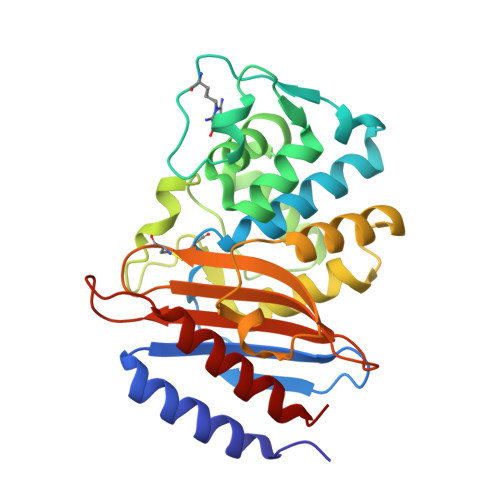qFit-ligand Reveals Widespread Conformational Heterogeneity of Drug-Like Molecules in X-Ray Electron Density Maps.
van Zundert, G.C.P., Hudson, B.M., de Oliveira, S.H.P., Keedy, D.A., Fonseca, R., Heliou, A., Suresh, P., Borrelli, K., Day, T., Fraser, J.S., van den Bedem, H.(2018) J Med Chem 61: 11183-11198
- PubMed: 30457858
- DOI: https://doi.org/10.1021/acs.jmedchem.8b01292
- Primary Citation of Related Structures:
6DMG, 6DMH, 6DMI, 6DMJ, 6DMK, 6DML - PubMed Abstract:
Proteins and ligands sample a conformational ensemble that governs molecular recognition, activity, and dissociation. In structure-based drug design, access to this conformational ensemble is critical to understand the balance between entropy and enthalpy in lead optimization. However, ligand conformational heterogeneity is currently severely underreported in crystal structures in the Protein Data Bank, owing in part to a lack of automated and unbiased procedures to model an ensemble of protein-ligand states into X-ray data. Here, we designed a computational method, qFit-ligand, to automatically resolve conformationally averaged ligand heterogeneity in crystal structures, and applied it to a large set of protein receptor-ligand complexes. In an analysis of the cancer related BRD4 domain, we found that up to 29% of protein crystal structures bound with drug-like molecules present evidence of unmodeled, averaged, relatively isoenergetic conformations in ligand-receptor interactions. In many retrospective cases, these alternate conformations were adventitiously exploited to guide compound design, resulting in improved potency or selectivity. Combining qFit-ligand with high-throughput screening or multitemperature crystallography could therefore augment the structure-based drug design toolbox.
- Schrödinger , New York , New York 10036 , United States.
Organizational Affiliation:



















